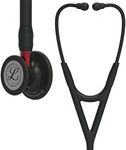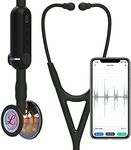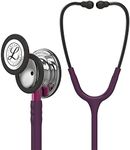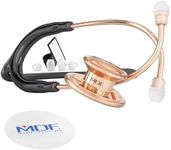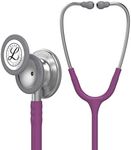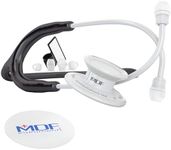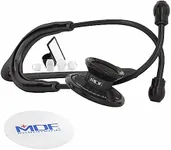Buying Guide for the Best Stethoscopes
Choosing the right stethoscope is crucial for healthcare professionals as it directly impacts their ability to accurately assess and diagnose patients. When selecting a stethoscope, consider the environment in which you'll be using it, the types of patients you'll be examining, and your personal comfort and hearing needs. A good stethoscope should provide clear acoustics, be comfortable to wear for extended periods, and be durable enough to withstand frequent use. Understanding the key specifications will help you make an informed decision that best suits your professional requirements.Acoustic PerformanceAcoustic performance refers to the clarity and volume of the sound that the stethoscope can pick up. This is important because it affects your ability to hear heartbeats, lung sounds, and other bodily noises clearly. Stethoscopes with higher acoustic performance are typically better for detecting subtle sounds, which is crucial in critical care settings. Acoustic performance can be divided into basic, intermediate, and advanced levels. Basic models are suitable for general use, intermediate models offer better sound quality for more detailed examinations, and advanced models provide the highest clarity for specialized fields. Choose based on the level of detail you need in your assessments.
Chestpiece TypeThe chestpiece is the part of the stethoscope that is placed on the patient to pick up sounds. It can be single-sided or dual-sided. Single-sided chestpieces often have a tunable diaphragm that can capture both low and high-frequency sounds by adjusting pressure. Dual-sided chestpieces have a diaphragm on one side and a bell on the other, allowing for more versatility in sound detection. If you need to frequently switch between different types of sounds, a dual-sided chestpiece might be more suitable. For those who prefer simplicity and ease of use, a single-sided chestpiece with a tunable diaphragm is a good choice.
Tubing LengthTubing length affects both the comfort and the acoustic performance of a stethoscope. Longer tubing allows for more distance between you and the patient, which can be beneficial in certain clinical settings for hygiene and comfort. However, longer tubing can sometimes reduce sound quality. Tubing lengths generally range from about 22 to 31 inches. Shorter tubing is often preferred for better sound transmission, while longer tubing is chosen for convenience and comfort. Consider your working environment and personal preference when deciding on the tubing length.
Earpiece ComfortEarpiece comfort is crucial for prolonged use of a stethoscope. The earpieces should fit snugly in your ears to block out ambient noise and provide a clear sound. They are typically made from soft silicone or rubber for comfort. Some stethoscopes come with interchangeable earpieces of different sizes to ensure a good fit. If you will be using the stethoscope for long periods, prioritize models with comfortable, adjustable earpieces to prevent discomfort and ensure a good acoustic seal.
DurabilityDurability refers to how well the stethoscope can withstand regular use and cleaning. A durable stethoscope is made from high-quality materials that resist wear and tear, such as stainless steel for the chestpiece and thick, flexible tubing. Durability is important because it ensures the stethoscope will last longer and maintain its acoustic performance over time. If you work in a busy or demanding environment, look for stethoscopes that are known for their robust construction and resistance to damage.
